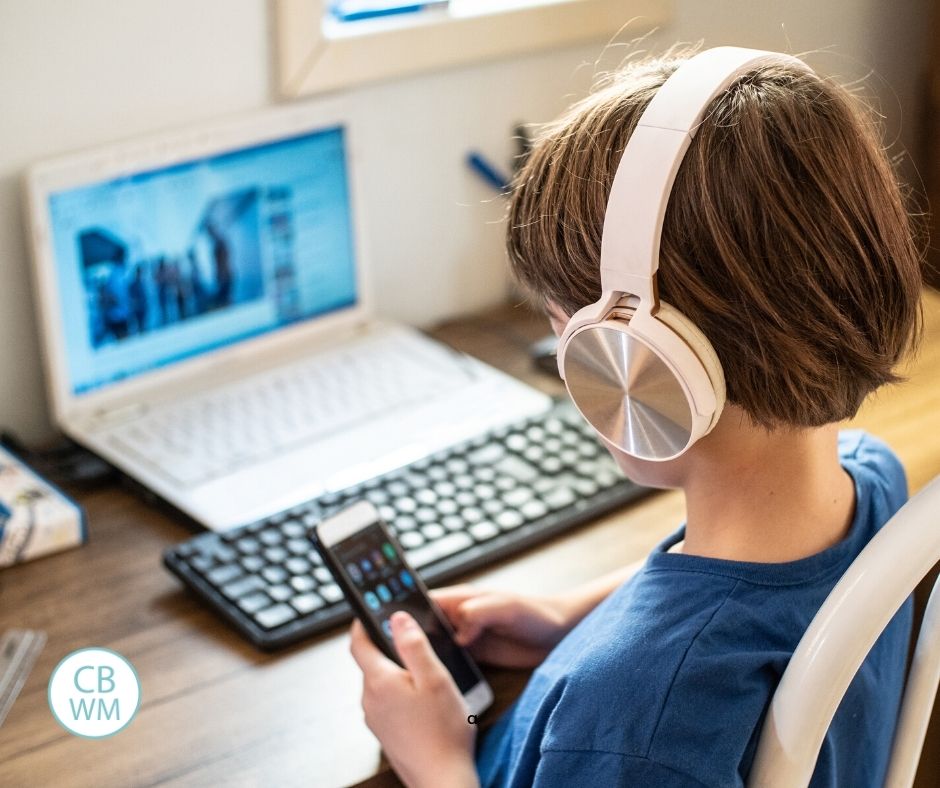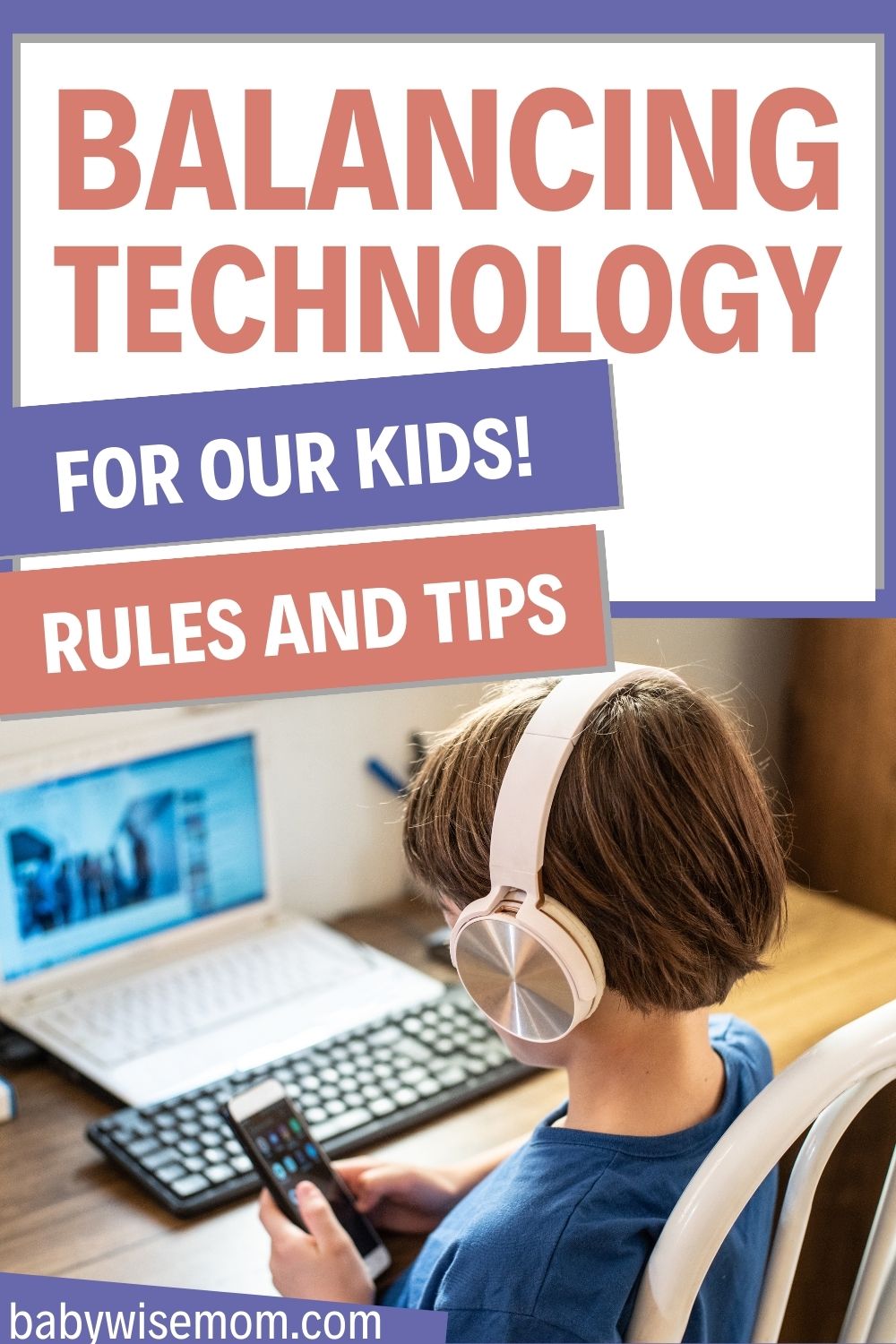How to raise kids in a technology-filled world. Help kids learn to use technology while setting limits and avoid getting addicted to tech.

Technology is everywhere.
We have our smartphones, computers, TVs, iThings, video games. Since we are really the first generation of parents to raise children in a complete technology era, we do not have the benefits of seeking wisdom from those who have “been there/done that” and get the tips for what to do, what not to do, how to limit, and what freedoms are appropriate.
I recently read “Keeping Safe & Balanced in a Google-YouTube-Twitter-Facebook-iEverything World” by Jan Pinborough and loved the ideas and advice in it. It is about staying safe and balanced with the technology around us. I will share ideas from it in this post.
Technology has many great purposes. We can accomplish a lot of amazing things with it–for example, grandparents living across the country (or world) can still see and talk to their grandchildren daily. Technology connects people. Technology can save our time.
But for every good, there is a potential bad as well.
It might have the ability to save time, but I think we all know it can definitely be a time suck.
I know if I don’t sit down at the computer with goals in mind, an hour can go by and I haven’t actually managed to accomplish anything other than some aimless surfing. And not the kind that exercises the body.
It can also distract us a great deal from reality, and I believe it is addicting. Not that it can be, that it is and that it needs to be monitored.
How often have you opened social media because you had an extra ten minutes only to realize 30 minutes went by without you noticing?
I have read that technology creates a chemical process in your brain that is addictive to the mind just as drugs are addictive to the body. I have no trouble believing that.
So I think it has great purposes–obviously. I wouldn’t be a blog writer if I thought technology was pure evil. I don’t.
But I do think it is addictive and that you need to monitor yourself and your children and often reevaluate your use of technology.
The article I linked provides some ideas on safety measures for technology–I wouldn’t consider myself knowledgeable in those areas and leave that kind of stuff to my husband, so I won’t pretend to know about it. If you are interested in the article’s recommendation, it is linked for your reading pleasure. There is a lot of information out there on internet safety.
Finding Balance
Like I said, our children are the first to grow up their entire lives with technology such a prevalent part of it.
I remember my senior year of high school seeing some advertisements during the super bowl for some internet sites. I remember my Dad and I making fun of those commercials. Who wants to hear about a website when they were watching TV? Well, we obviously were clueless.
When I was growing up, if I wanted to talk to a friend, I had to call the friend’s house and there was a good chance I would talk to a parent first.
In our modern-day, most teenagers have cell phones and many won’t call a friend if they have to call a house phone. Not having a cell phone can exterminate a teen’s social life.
I often see adults around my age or older on the Internet declaring an Internet fast because they have determined they have become addicted. These are responsible, busy adults with children who have realized they are spending more time than they should on…whatever.
>>>Read: How To Successfully Do a Technology Fast
We are in an interesting situation because we have this technology available to us that we didn’t have the benefit of having parents guide us on using responsibly as children. It didn’t exist when we were children (I know some of you are young enough that it did for you–just let me pretend I am younger than I am for now–thanks).
Jan Pinborough, author of the article I am referring to, says,
“An important element of parenting in the digital age is helping children establish limits for digital use. Children also need guidance in learning to wisely balance digital activities with reading, outdoor activities, physical exercise, creative play, service, work, and time with family.”
I love that. I believe it. I think an interesting challenge we face is that we are really learning how to balance all of that ourselves right now, aren’t we?
Some people could react by completely banning technology from their homes. I can’t say if that is good or not, but I will say it isn’t what I think is best. I think technology is here to stay, and rather than burrying it, I think it is wise to take Pinborough’s advice and teach our children how to balance technology so it is a normal part of life–not an obsessive part.
Ken Knapton, an Internet safety expert, says, “One reason it’s so easy to overuse digital activities is that they lack the kind of natural boundaries that help us moderate other activities. A child stops playing softball when his or her arm gets tired or when it gets too dark to see the ball. It’s much easier to ignore the subtle cues that tell us when it’s time to stop watching funny animal videos, looking at friends’ Facebook photos, or beating the next game level.”
That makes a lot of sense! I hadn’t ever thought of it in that way before.
We have a unique responsibility as parents right now. We need to teach our children something that we not only didn’t experience as children but haven’t necessarily mastered as adults.
Digital Rules for Kids
An important step in this responsibility is to set up digital rules for your family. Here are some general ideas for rules:
- Set time limits
- Have days and or times when technology is off-limits.
- Keep technology in full view of family (regularly check iPods, phones, etc. Also have the computer in a location that can easily be seen by family members)
10 Questions to Ask Yourself
As we think about the rules for our family, I thought of these questions to help guide policy:
- How much time is of value (even if the value is purely entertainment) and at what point does that value become overshadowed by a potential negative OR has simply reached its climax for value?
- What age do I want my child to have a cell phone (I have no conclusion on this at this point for our own family)?
- What types of technology are appropriate for my individual child?
- What, if any, impact do I see on my child after using various technologies?
- What will our policies be on technology outside the home (in waiting rooms, at siblings sporting events, etc)?
- What will our policies be on technology in the vehicle?
- What do I need to teach my child about using this technology safely?
- Is the use of technology impeding with my child’s other activities? Is my child still interested in playing with friends and family members? Is my child still getting enough exposure to the other varied facets of life?
- What will be our policy on technology when a child is sick or has other out-of-ordinary circumstances?
- What do we hope to gain from the use of this technology?
Next time, I will share the 10 signs of digital overload along with 10 ways to cut back that are found in the article. If you can’t wait, you can go read the original now 🙂
What guidelines do you use when setting technology rules for your family? What tricks have you found that help you and your family balance technology? Do you have specific rules at this point?
Related Posts
- Effective Parenting In The Digital Age
- The Tech-Wise Family Book Review
- What Age Should Kids Have Social Media Accounts?
- Rules for Balancing Screen Time
- How to Establish Safe Media Standards For Your Family
- Why You Shouldn’t Allow TV Time Under Two

